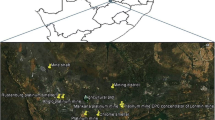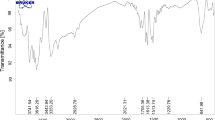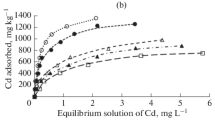Abstract
This work presents the problems left by a company that manufactured chrome-plated products for 20 years, without controlling its waste, until it was closed by the authorities in 1978. The raw material used was chromite (FeCr2O4). The presence of chromium in the groundwater has been observed in recent years. Hence, there is a need to understand the adsorption capacity of the soils and to explain the presence of chromium in the groundwater. The soils at the site are sandy silts with a minor presence of clay and fine sands, which would lead to an initial expectation of high adsorption. We analyzed the adsorption capacity of hexavalent chromium (CrVI+) in the soils based on adsorption isotherms, determined the charge of the soil particles, and evaluated Gibbs free energy. The adsorption capacity was evaluated for three soil samples (S1, S2, and S3), obtained from the core of a well drilled in 2009, at the site where the manufacturing plant was located and at two more sites within its radius of influence, in the direction of the underground water flow to ascertain that the chromium adsorption data obtained are representative for the aims of the study. Concentrations of total Cr and CrVI+ were analyzed throughout the core of the drilled wells, as well as the soil mass contained therein. The average concentration of total Cr was 43.5 mg/kg, with a total mass of 21.1 g; whereas for CrVI+, the average concentration was 4.37 mg/kg with a mass of 2.12 g. A rough estimate with these values indicates that in the affected area (16,000 m2) and at a depth of 65 m, where the current groundwater level starts, there will be 18.53 tons of total Cr and 1.86 tons of CrVI+. Adsorption isotherms were drawn and the linear, Freundlich, and Langmuir models applied; the Freundlich model was the best fit for two of the soils (S1 and S2), while for soil S3 it was the linear model. According to the values for the partition coefficient, K d, obtained, the three soils showed low adsorption values. The net surface charge for each of the soils was determined, observing that for a broad pH range the charge was negative, which contributed to the low sorption of hexavalent chromium in the soils. The average CrVI+ adsorbed was 0.34 mL/g. Although this value represents a very low adsorption, it is sufficient to reveal the presence of chromium, even after more than 30 years, in the soil particles, particularly considering the reduction of groundwater level, which implies that the zone where the saturated zone had been is currently not saturated, and that chromium remained adsorbed. Lastly, the AGº thermodynamic parameter was calculated for each soil. In all cases, the value for the Gibbs free energy was positive, reflecting that the processes are not spontaneous, which concurs with the low adsorption results.





Similar content being viewed by others
References
Abbasi SA, Soni R (1985) Environmental management and treatment of chromium. J Inst Eng Env Eng Div 65:113–117
Aranberri I, Bismarck A (2007) Caracterización superficial de minerales arcillosos presentes en los depósitos de crudo. An Quim 103(2):23–27
ASTM International (2007) Standard test method for particle-size analysis of soils (Standard D422-63[2007]). In: Annual Book of ASTM Standards, vol. 04.08, Soil and Rock (I), American Society for Testing and Materials, West Conshohocken. doi:10.1520/D0422-63R07
Bajpai S, Dey A, Jha MK, Gupta SK, Gupta A (2012) Removal of hazardous hexavalent chromium from aqueous solution using divinylbenzene copolymer resin. Int J Environ Sci Technol 9:683–690
Baruthio F (1992) Toxic effects of chromium and its compounds. Biol Trace Elem Res 32:145–153
Campos V, Morais LC, Buchler PM (2007) Removal of chromate from aqueous solution using treated natural zeolite. Environ Geol 52(8):1521–1525
Canter LW, Knox RC, Fairchild DM (1987) Groundwater quality protection. Lewis Publishers, Michigan
Castellan G (1976) Fisicoquímica. Fondo Educativo Interamericano, México
CONAGUA (Comisión Nacional del Agua) (2004) Opinión Técnica sobre la Contaminación del Agua Subterránea generada por la extinta empresa Cromatos de México, S.A., Tultitlán, Estado de México. Subdirección General Técnica. Gerencia de Aguas Subterráneas. Technical Report No. Gas/SEMG/2004/01. México, D.F
Cruz González VH (2009) Contaminación de agua potable por cromo hexavalente. Caso de estudio: Colonia Lechería, Municipio de Tultitlán, Estado de México. Tesis de Maestría. Instituto Politécnico Nacional. México, D.F. p 87
De la Llata Loyola MD (2001) Química Inorgánica. Editorial Progreso. México
Desjardin V, Bayard R, Huck N, Manceau A, Gourdon R (2002) Effect of microbial activity on the mobility of chromium in soils. Waste Manag 22(2):195–200
Freeze RA, Cherry JA (1979) Groundwater. Wiley, New York
Gutiérrez M, Castillo S, Bocco G (1988) Estudio de monitoreo y evaluación del cementerio industrial de Cromatos de México S.A. en Tultitlán, Edo. De México, segunda etapa. Instituto de Geografía- Facultad de Química, UNAM. México. p 137
II-UNAM (Instituto de Ingeniería, UNAM) (2009) Ejecución de pruebas de bombeo y de tres pozos de monitoreo para el saneamiento del acuífero Cuautitlán-Pachuca contaminado localmente en el municipio de Tultitlán, Edo. de México. No. de convenio SGT-GAS-002-2008
Khérici-Bousnoubra H, Kherici N, Derradji EF, Rousset C, Caruba R (2009) Behaviour of chromium VI in a multilayer aquifer in the industrial zone of Annaba. Alger Environ Geol 57(7):1619–1624
Losi ME, Amrhein C, Frankenberger WT Jr (1994) Factors affecting chemical and biological reduction of hexavalent chromium in soil. Environ Toxicol Chem 13(11):1727–1735
Netzahuatl A (2009) Selección y caracterización de un biomaterial capaz de remover cromo hexavalente y cromo total de soluciones acuosas. Tesis de Doctorado. Instituto Politécnico Nacional. Escuela Nacional de Ciencias Biológicas, México D.F. p 231
NMX-AA-044-SCFI (2001) Análisis de aguas—determinación de cromo hexavalente en aguas naturales, potables, residuales y residuales tratadas—método de prueba. CONAGUA, México, D.F. p 21
Patterson RR, Fendorf S, Fendorf M (1997) Reduction of hexavalent chromium by amorphous iron sulfide. Environ Sci Technol 31(7):2039–2044
Pawlisz AV, Kent RA, Scheneider UA, Jefferson C (1997) Canadian water quality guidelines for chromium. Environ Toxicol Water 12(2):123–183
Reynaud PH (2005) Behavior of chromium and arsenic in a free water table under an industrial site. Université de Pau, France. Doctoral Thesis. Univ Pau. 88-105
SARH (Secretaría de Agricultura y Recursos Hidráulicos) (1978) Dictamen técnico sobre el problema de Contaminación por Cromo, en aguas subterráneas de la zona de Tultitlán, Edo. de México. Subsecretaría de Planeación. Dirección General de Protección y Ordenación Ecológica
Shtiza A, Swennen R, Cappuyns V, Tashko A (2009) ANC, BNC and mobilization of Cr from polluted sediments in function of pH changes. Environ Geol 56(8):1663–1678
Sotelo Muñoz A (2012) Especiación de cromo en la solución del suelo de tres suelos enmendados con biosólidos bajo diferentes condiciones oxidoreductoras. MS thesis. Universidad Nacional de Colombia, Sede Medellín. p 72
Tandon RK, Crisp PT, Ellis J, Baker RS (1984) Effect of pH on chromium (VI) species in solution. Talanta 31(3):227–228
Tiwary RK, Dhakate R, Ananda Rao V, Singh VS (2005) Assessment and prediction of contaminant migration in ground water from chromite waste dump. Environ Geol 48:420–429
Zouboulis AI, Kydros KA, Matis KA (1995) Removal of hexavalent chromium anions from solutions by pyrite fines. Water Res 29(7):1755–1760
Author information
Authors and Affiliations
Corresponding author
Rights and permissions
About this article
Cite this article
Castro-Rodríguez, A., Carro-Pérez, M.E., Iturbe-Argüelles, R. et al. Adsorption of hexavalent chromium in an industrial site contaminated with chromium in Mexico. Environ Earth Sci 73, 175–183 (2015). https://doi.org/10.1007/s12665-014-3405-4
Received:
Accepted:
Published:
Issue Date:
DOI: https://doi.org/10.1007/s12665-014-3405-4




